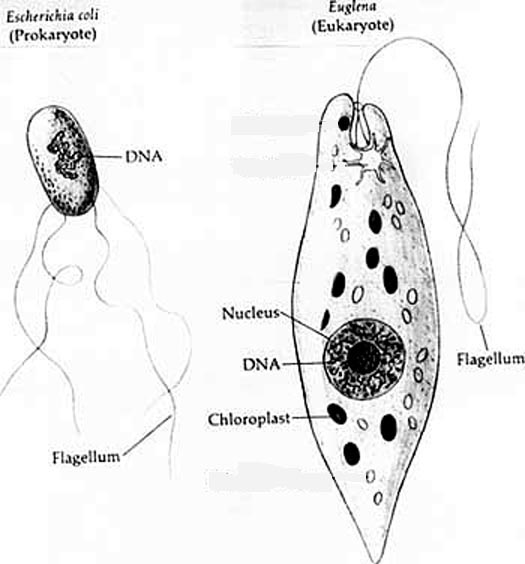The Road to Advanced Life
Key points: Steps in evolution: nucleated
cells, sex, biological switches; Cambrian Explosion; first vertebrates
| All the evidence collected since 1859 agrees with Darwin's conclusion
- life appears to have evolved from a common ancestor that sprang forth more than 3.5
billion years ago. We now describe what we know about how this evolution occurred. |
"All living things have much in common, in their chemical
composition, their germinal vesicles, their cellular structure, and their laws of growth
and reproduction. Therefore I whould infer that probably all the organic beings which have
ever lived on the earth have descended from some one primordial form." - Charles
Darwin, The Origin of Species, 1859 |
Conditions on the early earth should have been favorable for the evolution of more
complex life and even animals. But it didn't happen! For 1.5
- 2 billion years, the only life forms we can find are very similar to the first primitive
bacteria and stromatolites pictured above.
 |
Then the first cells with distinct
nuclei appear (picture from
http://www.sp.uconn.edu/~terry/ images). (technically, non-nuclear cells are prokaryotes
and nuclear ones are eukaryotes). It is thought that these represent the merger of two
cells -- one engulfed the other, but instead of it being digested, it took up residence in
its new environment. Nucleated cells have a tremendous advantage -- the nucleus need not
carry out all the functions to survive in the outside world, like keeping the world out,
and hence is free to become specialized -- for example, the DNA that encodes the
reproduction is now stored in cell nuclei. In the prokaryote, the DNA is in a single
chromosome that just "floats" in the cell. We have come to believe that
eukaryotes should be considered as cooperative symbiotic colonies of cells, with the
nucleus and other structures such as chloroplasts representing forms of prokaryote that
have "banded together" to allow specialization and a more complex set of
capabilities. |
 |
Here is a true "living fossil' -- the primitive eukaryote type
cell that causes guardia! |
Nucleated cells could be much more efficient in operating on
their own, and more importantly their ability to specialize made it advantageous for them
to associate with each other into multi-cellular organisms where different cells have
different specializations.
About 1 billion years ago, there was another
advance - sex. Life forms appeared where the full set of DNA for reproduction had to be
drawn from two separate organisms, female and male. The mixing of genetic characteristics
among organisms as a result of sexual reproduction suddenly increased the diversity of
life immensely. Look at the examples below to understand why:
 |
Four individuals at the top have minor variations in their X and Z
chromosomes that carry the code for their reproduction. Because they to not exchange
genetic matter to reproduce (i.e., do not "have sex"), their offspring are
genetically identical to the parents, and even after many generations have passed there
are only four genetically distinct types. |
 |
Four individuals at the top start with the same set of X and Z
chromosomes as in the case above. However, these parents reproduce sexually (exchanging
genetic material), so after many generations their descendents show all possible mixtures
of the X and Z chromosomes -- even in this simple case, there are 16 distinct genetic
types. |
Thus, when mutations occurred, they resulted in a huge variety of organisms. The
fittest survived, leading to rapid improvement in the ability of the plants and animals to
survive and compete. Thus, sexual reproduction by specialized, eukaryote cells increased
the rate of evolution toward complex organisms.
 |
Plants
and a few forms of simple animals began to evolve. from Rick
Miller, http://www-rohan.sdsu.edu/~rhmiller/fossil_record/ediac4.htmSome fossils from this era are below
(with centimeter rules for scale), from G. M. Narbonne, Queens Univ.,
Newfoundland, Canada 
 Fossils from Mistaken Point,
Newfoundland Fossils from Mistaken Point,
Newfoundland
|
These plants and animals were built by making a series of slightly modified copies
of a small number of biological designs. This type of construction was another huge
advance, and remains the way plants and animals develop today. The development process is
controlled by biological "switches" that regulate the way large numbers of cells
grow and organize themselves. As a result, evolution could proceed - a change in a switch
is sufficient to produce a coherent, new form of organism.
Compare these two re-creations of the Cambrian sea floor below
with the one above for the Vendian/Ediacaran era. Both Cambrian reconstructions are
dominated by the super-predator anomalocaris, but with a huge variety of other animal
types. For the first time, predators hunted other animals that protected themselves with
shells, spines, and other devices. (Nat. Mus. Mat. Hist., http://www.nmnh.si.edu/paleo/shale/pamsci.htm;
Royal Tyrrell Museum, picture by M. Rieke)
| Reconstruction of anomalocaris, the dominant predator that grew up to
two feet in length |
This awesome hunter (4 - 6 times larger than any other animal) swam
the seas searching for food, which it captured with its claws and pulled into a round
mouth lined with teeth. animation from D. Quinn, Paleoindustrial, http://www.paleoindustrial.com/Anomalocaris%20-%20Swimming.htm. |
 |
 |
These specimens of other creatures (typically a few inches long) are based on
fossils from the Burgess Shale, in the Canadian Rockies on the border between British
Columbia and Alberta.
Wiwaxia |
Opabinia |

|
 |
Halucenia |
Trilobite |
 |
 |
The Cambrian era ended with a mass extinction, for which we are unsure of the
cause.
Nonetheless, complex multi-cellular animals and plants continued to evolve, with
intelligent life emerging only 500 million years later! An overview can be found in:
http://www.ucmp.berkeley.edu/cambrian/camb.html,
http://www.peripatus.gen.nz/Paleontology/Cambrian.html,
http://www.gpc.edu/~pgore/geology/geo102/cambrian.htm.
This narrative suggests that forming
"life" in the form of cyanobacteria and stromatolites is not equivalent to
forming complex organisms with intelligence
-- from the time intervals, it would appear that the
critical and difficult steps may have been the formation of cells with nuclei
(eukaryotes) and then the breakthrough to complex animals.
Test your understanding before going on
 God gives life to Adam,
on the ceiling of the Sistine Chapel, by Michelangelo. God gives life to Adam,
on the ceiling of the Sistine Chapel, by Michelangelo. |

|

A comet rips the earth apart in this 19th century cartoon, (From C.
Chapman, http://www.boulder.swri.edu/clark/chance/23oldcom.jpg) |
Click to return to syllabus |
| Click to return to Formation of Life |
hypertext  G. H. Rieke G. H. Rieke |
Click to go to Mass Extinctions |






 Fossils from Mistaken Point,
Newfoundland
Fossils from Mistaken Point,
Newfoundland














